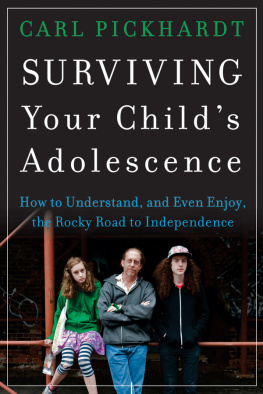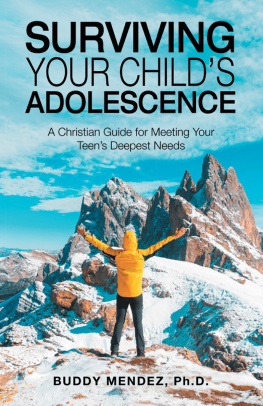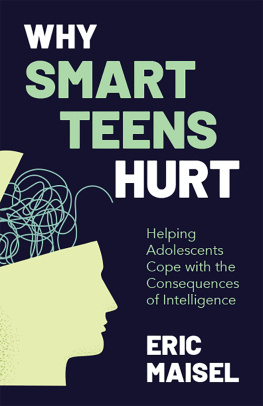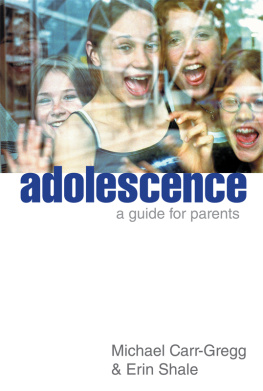I thank my children for the parenting lessons they taught me as they grew into adults. All four are different with wonderful talents and interesting perspectives.
My thanks to Dr. Ryan Donlan, associate professor of educational leadership at Indiana State University; Dr. Nanette Johnson Curiskis, professor emerita from Minnesota State University, Mankato; Dr. Angela Sewall, dean emerita of the College of Education at the University of Arkansas at Little Rock; and Dr. Mindy Kronenberg, a psychologist specializing in issues of children, for their review of my writing and their helpful suggestions.
I appreciate the works of Dr. William Alexander, the father of the middle school, and Dr. John Santrock, for his work on adolescence.
Finally, I admire adolescentspast, current, and futurefor negotiating what might be the hardest part of their lives. Coping with their miraculous physical, emotional, social, and hormonal changes deserves kudos.
Adolescence is a time when optimal development is stimulated through exploration, making and learning from mistakes, and trying on identities. (National Education Policy Center, 2019)
WHAT IS AN ADOLESCENT?
An adolescent is:
a weight watcher who goes on a diet by giving up candy bars before breakfast
a youngster who receives her allowance on Monday, spends it on Tuesday, and borrows from her best friend on Wednesday
someone who can hear a (popular) song three blocks away but not his mother calling from the next room
a whiz who can operate the latest electronic device without a lesson but cant make a bed
a student who will spend twelve minutes studying for her history exam and twelve hours studying for her drivers license
an enthusiast who has the energy to ride a bike for miles but is usually too tired to dry the dishes
a connoisseur of two kinds of musicloud and very loud
a young woman who loves the cat and tolerates her brother
a person who is always late for dinner but always on time for a (pop music) concert
a romantic who never falls in love more than once a week
a budding beauty who never smiles until her braces come off
a boy who can sleep until noon on any Saturday when he suspects the lawn needs mowing
an original thinker who is positive that her mother never was a teenager. (Adler, 1986)
Youngsters between the ages of 10 and 14 are a unique and special group of people. They are no longer children who are wholly dependent on their parents and other adults for guidance and direction, but neither are they totally self-sufficient.
These preadolescents and early adolescentstweenagersare mystified by the changes they are experiencing. They are going through the most remarkable and scary time of their lives as they enter puberty and emerge as adolescents.
Most adults who live and work with these special people are not prepared for the remarkable changes that occur. The most noticeable change is physical. The long bones begin their final massive growthpants seem to get shorter day by day; full-length skirts become mini-skirts in what seems like only a week or two. Hips get wider, and chests get broader. Struggling children get much stronger, and voices get deeper. Whiskers appear. And there is the exciting/traumatic shopping trip for the first bra.
Puberty takes about a year and a half to three years to complete. Youngsters have difficulty during this period. Some have been known to trip on lint in the carpet. Others have been heard to sing soprano one day and squeaky baritone the next. Still others can begin to solve higher-order mathematical problems, yet have trouble following simple directions for setting the dinner table.
In addition to the physical growth surge, adolescents also grow emotionally, socially, and intellectually, and in their ability to coordinate their bodies. They have an increased need for fuel, which is why they seem to be eating constantly.
Their body regulators are shifting. They may have boundless energy at some times and are listless at other times. They also are more able to deal with abstractions but are confused by romantic feelings.
One of the most profound changes is in their need for identity and independence. The roller-coaster ride has begun.
They are confronted with the question of self-concept: Who am I? What am I? Why am I here? What am I capable of doing? Parents and teachers are observing an individual going through the remarkable changesthe metamorphosiscalled puberty.
Suddenly, the baby that you have loved and cared for seems to have turned into an egocentric chameleon. Where is your lovable child, and will she ever return? What happened to that sweet and compliant elementary school child?
CONFUSION
Many parents feel confused when their children enter their adolescent years. Nothing they have experienced up to this point in their lives has prepared them for the emotional roller-coaster ride that confronts them.
Do the children survive? Probably. Do the parents survive? Most likely. This time in the relationship of parent and child will be a time of more in-depth power struggles and testing of boundaries.
PREPARATION
How do you prepare yourself for childrens adolescence? Preparation should begin at a much earlier time in the childs life than at the brink of adolescence.
When the child is still a small being and the parent plays a much larger role in helping form an impression, the child can and should be given unconditional love, self-worth, encouragement, and increasing independence.
Independence is not total freedom of behavior and lack of structure, but rather a gradual progression into appropriate decision making. The youngster makes decisions that are appropriately hers and accepts the consequences of those decisions.
Our society does a poor job of making a place for adolescents. (Societal) changes have left adolescents in a social and psychological no-mans land. They can consume, but not produce; they can be educated, but not apply the education; they have increasing independence, but often no greater responsibilities than getting their homework done and keeping their rooms clean. Rapid technology has created a knowledge gap between generations; divorce and separation leave many adolescents isolated from adults who can serve as role models (Taibbi, 1990, p. 33).
When adults become parents, the resource they have to draw upon is how they were parented. In many respects, people are as good at parenting as what their parents were. They can choose to improve on what they experienced for the benefit of their own children, as well as for their own growth. (Teachers also fall prey to repeating the pattern of their own history. They tend to teach as they were taught.)
How can there be improvement in your own parenting compared to how you were parented? Look back at your own childhood and remember the things you wished had been different. You may have wanted your parents to have listened to you more, given you more freedom of choice, offered their respect, or given you a hug of assurance when you were afraid or apprehensive about something.







